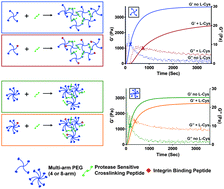Characterization of the crosslinking kinetics of multi-arm poly(ethylene glycol) hydrogels formed via Michael-type addition†
Abstract
Tunable properties of multi-arm poly(ethylene glycol) (PEG) hydrogel, crosslinked by Michael-type addition, support diverse applications in tissue engineering. Bioactive modification of PEG is achieved by incorporating integrin binding sequences, like RGD, and crosslinking with tri-functional protease sensitive crosslinking peptide (GCYKNRGCYKNRCG), which compete for the same reactive groups in PEG. This competition leads to a narrow range of conditions that support sufficient crosslinking density to provide structural control. Kinetics of hydrogel formation plays an important role in defining the conditions to form hydrogels with desired mechanical and biological properties, which have not been fully characterized. In this study, we explored how increasing PEG functionality from 4 to 8-arms and the concentration of biological moieties, ranging from 0.5 mM to 3.75 mM, affected the kinetics of hydrogel formation, storage modulus, and swelling after the hydrogels were allowed to form for 15 or 60 minutes. Next, human bone marrow stromal cells were encapsulated and cultured in these modified hydrogels to investigate the combined effect of mechano-biological properties on phenotypes of encapsulated cells. While the molar concentration of the reactive functional groups (-vinyl sulfone) was identical in the conditions comparing 4 and 8-arm PEG, the 8-arm PEG formed faster, allowed a greater degree of modification, and was superior in three-dimensional culture. The degrees of swelling and storage modulus of 8-arm PEG were less affected by the modification compared to 4-arm PEG. These findings suggest that 8-arm PEG allows a more precise control of mechanical properties that could lead to a larger spectrum of tissue engineering applications.


 Please wait while we load your content...
Please wait while we load your content...